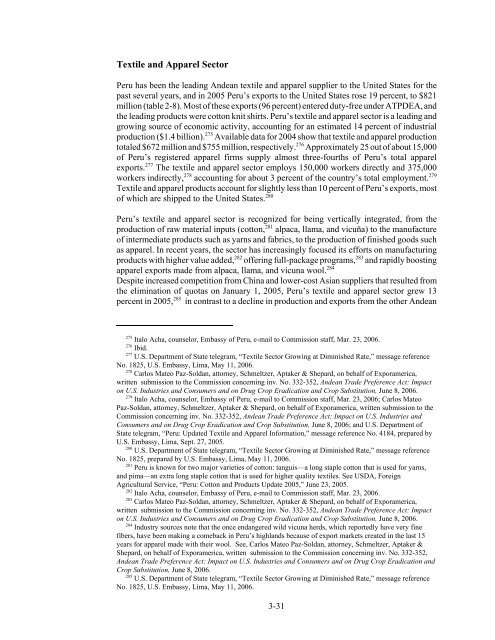The Impact of the Andean Trade Preference Act Twelfth ... - USITC
The Impact of the Andean Trade Preference Act Twelfth ... - USITC
The Impact of the Andean Trade Preference Act Twelfth ... - USITC
- No tags were found...
Create successful ePaper yourself
Turn your PDF publications into a flip-book with our unique Google optimized e-Paper software.
Textile and Apparel SectorPeru has been <strong>the</strong> leading <strong>Andean</strong> textile and apparel supplier to <strong>the</strong> United States for <strong>the</strong>past several years, and in 2005 Peru’s exports to <strong>the</strong> United States rose 19 percent, to $821million (table 2-8). Most <strong>of</strong> <strong>the</strong>se exports (96 percent) entered duty-free under ATPDEA, and<strong>the</strong> leading products were cotton knit shirts. Peru’s textile and apparel sector is a leading andgrowing source <strong>of</strong> economic activity, accounting for an estimated 14 percent <strong>of</strong> industrialproduction ($1.4 billion). 275 Available data for 2004 show that textile and apparel productiontotaled $672 million and $755 million, respectively. 276 Approximately 25 out <strong>of</strong> about 15,000<strong>of</strong> Peru’s registered apparel firms supply almost three-fourths <strong>of</strong> Peru’s total apparelexports. 277 <strong>The</strong> textile and apparel sector employs 150,000 workers directly and 375,000workers indirectly, 278 accounting for about 3 percent <strong>of</strong> <strong>the</strong> country’s total employment. 279Textile and apparel products account for slightly less than 10 percent <strong>of</strong> Peru’s exports, most<strong>of</strong> which are shipped to <strong>the</strong> United States. 280Peru’s textile and apparel sector is recognized for being vertically integrated, from <strong>the</strong>production <strong>of</strong> raw material inputs (cotton, 281 alpaca, llama, and vicuña) to <strong>the</strong> manufacture<strong>of</strong> intermediate products such as yarns and fabrics, to <strong>the</strong> production <strong>of</strong> finished goods suchas apparel. In recent years, <strong>the</strong> sector has increasingly focused its efforts on manufacturingproducts with higher value added, 282 <strong>of</strong>fering full-package programs, 283 and rapidly boostingapparel exports made from alpaca, llama, and vicuna wool. 284Despite increased competition from China and lower-cost Asian suppliers that resulted from<strong>the</strong> elimination <strong>of</strong> quotas on January 1, 2005, Peru’s textile and apparel sector grew 13percent in 2005, 285 in contrast to a decline in production and exports from <strong>the</strong> o<strong>the</strong>r <strong>Andean</strong>275Italo Acha, counselor, Embassy <strong>of</strong> Peru, e-mail to Commission staff, Mar. 23, 2006.276 Ibid.277 U.S. Department <strong>of</strong> State telegram, “Textile Sector Growing at Diminished Rate,” message referenceNo. 1825, U.S. Embassy, Lima, May 11, 2006.278Carlos Mateo Paz-Soldan, attorney, Schmeltzer, Aptaker & Shepard, on behalf <strong>of</strong> Exporamerica,written submission to <strong>the</strong> Commission concerning inv. No. 332-352, <strong>Andean</strong> <strong>Trade</strong> <strong>Preference</strong> <strong>Act</strong>: <strong>Impact</strong>on U.S. Industries and Consumers and on Drug Crop Eradication and Crop Substitution, June 8, 2006.279Italo Acha, counselor, Embassy <strong>of</strong> Peru, e-mail to Commission staff, Mar. 23, 2006; Carlos MateoPaz-Soldan, attorney, Schmeltzer, Aptaker & Shepard, on behalf <strong>of</strong> Exporamerica, written submission to <strong>the</strong>Commission concerning inv. No. 332-352, <strong>Andean</strong> <strong>Trade</strong> <strong>Preference</strong> <strong>Act</strong>: <strong>Impact</strong> on U.S. Industries andConsumers and on Drug Crop Eradication and Crop Substitution, June 8, 2006; and U.S. Department <strong>of</strong>State telegram, “Peru: Updated Textile and Apparel Information,” message reference No. 4184, prepared byU.S. Embassy, Lima, Sept. 27, 2005.280U.S. Department <strong>of</strong> State telegram, “Textile Sector Growing at Diminished Rate,” message referenceNo. 1825, prepared by U.S. Embassy, Lima, May 11, 2006.281 Peru is known for two major varieties <strong>of</strong> cotton: tanguis—a long staple cotton that is used for yarns,and pima—an extra long staple cotton that is used for higher quality textiles. See USDA, ForeignAgricultural Service, “Peru: Cotton and Products Update 2005,” June 23, 2005.282Italo Acha, counselor, Embassy <strong>of</strong> Peru, e-mail to Commission staff, Mar. 23, 2006.283Carlos Mateo Paz-Soldan, attorney, Schmeltzer, Aptaker & Shepard, on behalf <strong>of</strong> Exporamerica,written submission to <strong>the</strong> Commission concerning inv. No. 332-352, <strong>Andean</strong> <strong>Trade</strong> <strong>Preference</strong> <strong>Act</strong>: <strong>Impact</strong>on U.S. Industries and Consumers and on Drug Crop Eradication and Crop Substitution, June 8, 2006.284 Industry sources note that <strong>the</strong> once endangered wild vicuna herds, which reportedly have very finefibers, have been making a comeback in Peru’s highlands because <strong>of</strong> export markets created in <strong>the</strong> last 15years for apparel made with <strong>the</strong>ir wool. See, Carlos Mateo Paz-Soldan, attorney, Schmeltzer, Aptaker &Shepard, on behalf <strong>of</strong> Exporamerica, written submission to <strong>the</strong> Commission concerning inv. No. 332-352,<strong>Andean</strong> <strong>Trade</strong> <strong>Preference</strong> <strong>Act</strong>: <strong>Impact</strong> on U.S. Industries and Consumers and on Drug Crop Eradication andCrop Substitution, June 8, 2006.285U.S. Department <strong>of</strong> State telegram, “Textile Sector Growing at Diminished Rate,” message referenceNo. 1825, U.S. Embassy, Lima, May 11, 2006.3-31
















